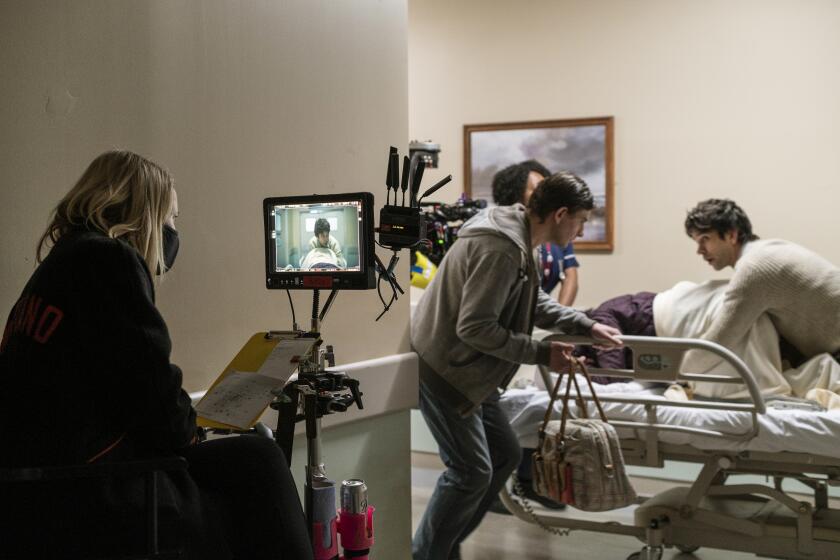Starlight Runner Entertainment creates mythology behind movie franchises
With their mania for film franchises, leading studios are behaving more like packaged goods marketers than the showmen of yore in pumping out movies, and appear more interested in taking direction from fanboys, brand managers and multimedia consultants.
So the time appears ripe for consultants such as Jeff Gomez and Mark Pensavalle, co-founders of Starlight Runner Entertainment. Their job: To make sure that stories and characters remain consistent as a movie is reincarnated as, say, a TV series, a video game, a theme park attraction or an online virtual world.
Their specialty is called transmedia, a term with roots in academia that has become the latest buzzword for entertainment that spans multiple media platforms. They have worked on some of the industry’s highest-profile properties, including the movies “Tron: Legacy” and “Avatar” and the video game Halo.
“We think we have shown that different media are like instruments, and when you put them together, you can create moving symphonies,” said Gomez, who oversees the creative aspects while Pensavalle focuses on the business side.
Spinoff entertainment from movies isn’t new in Hollywood. Even “Lassie” was treated to endless sequels by MGM in the 1940s before being turned into a live show on the fair circuit, a radio series, a network TV series, a cable TV series, books, comics and a merchandizing bonanza that included a line of dog food.
In the past, such renditions and products were typically considered ancillary, to be licensed to the highest bidder. As a result, video games, comics, websites and movies would vary in the complexity of their storytelling, if they didn’t outright contradict what came before.
But fans today, who can stay involved with stories and characters around the clock thanks to the Internet and mobile devices, are more sophisticated and less tolerant when it comes to deviations from the script.
“The merging of technology and media today demands that we’re more holistic in our thinking,” said “Tron: Legacy” producer Sean Bailey, president of production at Walt Disney Studios, which launched the movie in December along with a theme park show, toys, video games and an upcoming animated series. “It’s no longer OK to be sending mixed messages.”
Although studios actively manage their franchises on the business side, some are just starting to build up the same internal capability on the story side. That has provided an opening for firms like Starlight Runner and rivals such as 42 Entertainment and Campfire, which do similar work with a marketing bent.
On “Tron: Legacy” and the second and third “Pirates of the Caribbean” films, the six-person team at Starlight, based in New York, served as a bridge between the filmmakers and the people behind the theme park attractions, games and cruise line shows.
The Starlight team helped flesh out storylines for spinoffs that fit the movies and came up with moments to connect the different incarnations. In one such “transmedia tip,” Olivia Wilde’s character in “Tron: Legacy” discusses how she was saved from death. Players of the video game Tron: Evolution — a prequel to the movie — would recognize the reference, since they are the ones who rescue her at the end of the game.
They also led what Gomez called Tron 101 and Pirates 101 sessions for corporate executives at Disney, in which they outlined the mythology behind the franchises and explained the do’s and don’ts of creating products connected to it. Those seeking to use Johnny Depp’s Jack Sparrow character, for instance, were warned that although he’s selfish and a trickster, he would never murder an innocent person or act out of malicious intent.
On Microsoft’s video game Halo and Hasbro’s toy line Transformers, Gomez and Pensavalle had the opposite task: to simplify the mythology. Both brands had built up complex and sometimes conflicting narratives over the years that the companies behind them wanted to streamline as they prepared to launch games, toys and TV shows.
The Starlight team had to figure out which story points and characters should be discarded to clarify “the essence of the brand,” as Gomez calls it. For Transformers, they recommended that Hasbro pare the number of characters with overlapping traits, a suggestion that fans can see in a new animated series featuring the alien robots.
In each case, Starlight creates a “bible” of 100 to 400 pages that lays out facets of the fictional universe, similar to those used for years on TV shows and comic book series.
Such documents are usually distributed only on a need-to-know basis, Gomez explained, because they contain the “super-story arc,” a mythology of the universe that can be used for years.
The process doesn’t always go smoothly, however.
On “Avatar,” the Starlight team spent time with director James Cameron and his producing partner, Jon Landau, to learn their vision and communicate it to 20th Century Fox, the studio backing and distributing the film, for use in spinoffs.
But some of the resulting products, in particular a video game, were widely panned.
“I think our transmedia campaign was mediocre,” Landau said. “We were concerned about letting our partners in on what we were doing early in the process, but the lesson is that next time we need to do exactly that.”
The partners date the concept behind their business to their childhood together in the 1970s and 1980s in Queens, N.Y., and in particular the role-playing game Dungeons & Dragons. In the popular game, players create fantasy characters — including mighty warriors and powerful wizards — which guide them through a series of adventures as they battle monsters and other enemies.
Gomez served as Dungeon Master, the person who creates the scenario for other players and narrates the action. Inspired by his love for Japanese animation, which feature intersecting storylines between different media, he led intricate games of Dungeons & Dragons.
“Usually you have to follow a strict set of parameters, but [Gomez] would let us go off script and play it in a very showy way,” Pensavalle said.
After going their separate ways for more than a decade — Pensavalle, 47, worked in book publishing, Gomez, 47, worked in comic books and directed a short film — the two reunited to start an online entertainment company in 2000. It fizzled when the dot-com boom ended the next year, but a chance connection to an associate from Gomez’s days in the comic book industry led to a job helping Mattel relaunch Hot Wheels.
They ended up creating a “media universe” for the toy race cars, including an animated TV show and comic books. Other jobs soon followed as the Starlight founders found themselves in the right spot at the right time for Hollywood’s preoccupation with franchises, as an early entrant to what has now become a dominant sector of the movie industry.
Gomez and Pensavalle readily admit that not every big entertainment launch needs a transmedia campaign. Sometimes a movie is just a movie.
But they think there is room for more transmedia, and they want to get involved in creating some from the outset. The two colleagues are planning to seek partners on several projects they have created. One, titled “GoRizer,” about a teenager on the run in a postindustrial world, is intended to start in social media and expand into publishing and video games, film or television.
The Starlight founders are aiming to retain equity in their creations and personally steer them through their incarnations.
In other words, no transmedia consultants required.






